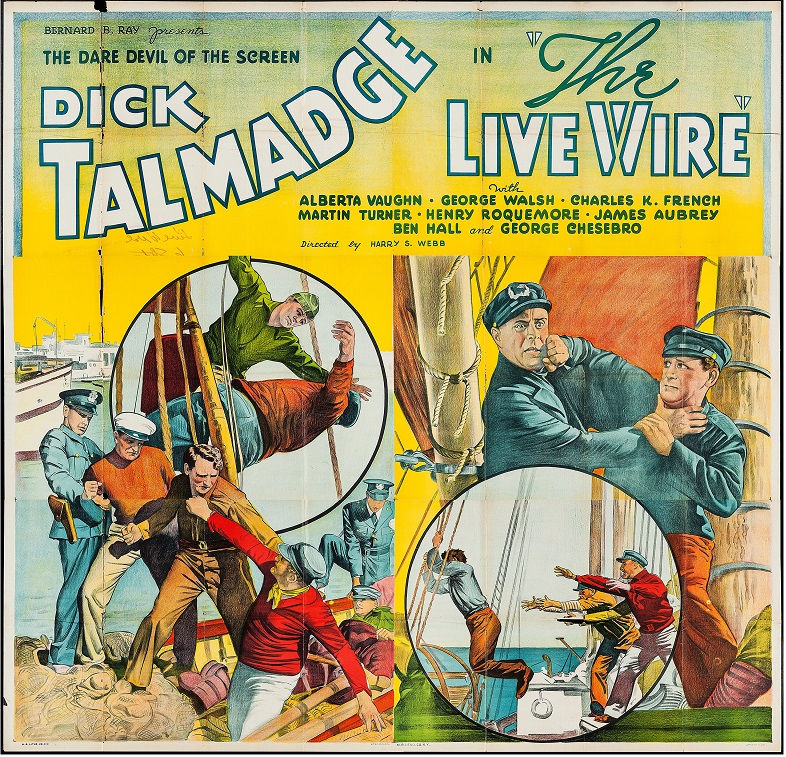 Richard Talmadge double feature
Richard Talmadge double featureOn Thursday, November 9, The Secret Cinema will launch a new, occasional sub-series called THE SECRET CINEMA CONNOISSEUR SERIES. While we've frequently (always?) explored the lesser-seen realms of film history in our screenings, the CONNOISSEUR SERIES is meant to provide an outlet for films in our archive, especially features, that are so obscure that we've never figured out how to showcase them before. On first glance they may not have obvious appeal, but we feel these curios will reward the true film buffs in our audience.
Our initial CONNOISSEUR SERIES offering is a double feature (each of them less than an hour long) showcasing the multi-talents of Hollywood veteran Richard Talmadge. Who?
Richard Talmadge was born as Ricardo Metzetti in either Germany or Switzerland (accounts vary) in 1892 or 1896 (ditto), and emigrated to the U.S.A. as a boy with his brothers, who worked together as an acrobat troupe in the Barnum & Bailey Circus. In 1910 he arrived in Hollywood and soon was working as a stunt man in silent films, even doubling for Douglas Fairbanks. He then became an actor, starring in countless independent silent and early sound features and serials, which usually featured exciting stunt work. He later transitioned to a second unit director, handling action sequences well into the 1960s on such films as CASINO ROYALE and WHAT'S NEW PUSSYCAT. Talmadge may have had one of the longest and most prolific careers in all of Hollywood, with credits as actor, producer, director, and writer in scores of films, in addition to his usually uncredited stunt work in many more.
There will be one complete show at 8:00 pm. Admission is free.
As always, all Secret Cinema presentations are projected with 16mm film on a giant screen (not digital, not video).
The program will include:
DETOUR TO DANGER (1946, Dir: Richard Talmadge and Harvey Parry)
Stumbling upon a good print of this unusual film was the real inspiration for this program. In the 1940s, Talmadge and fellow stunt man Harvey Parry formed a production company called Planet Pictures, with a novel strategy for filmmaking success: They would produce b-movies, shorts and cartoons using lower cost 16mm equipment. Then, they would market their product directly to non-theatrical film users that owned 16mm projectors (schools, churches, clubs, military, and even private homes), a market that was expanding rapidly after World War II. All of Planet Pictures' films would be made in Kodachrome color. Ads were placed in hobbyist magazine Home Movies, while Hollywood trade publications fretted in editorials about this new threat to traditional film distribution. Some theaters installed 16mm projectors to accommodate showings, but there is no evidence that DETOUR TO DANGER was ever blown up to 35mm, which would have been needed for wider distribution (decades later that would become a common cost-saving scheme for low budget filmmaking). Thus, DETOUR TO DANGER had a limited audience on its initial release, largely in special one-time showings at school auditoriums, playgrounds, and clubs, though it did turn up on black and white television screens in the late 1950s.
DETOUR TO DANGER is very much a homemade looking feature. The plot is minimal, about the two male heroes getting mixed up with payroll thieves in a resort hotel in Big Bear Lake, California, and the story is described in some reference books as a "comedy-drama." Unsurprisingly (considering who made it), there are stunt-filled fight scenes galore, but perhaps the most enjoyment comes from the gorgeous Kodachrome photography of mid-century Americana, from the resort cabins to an old roadside gas station where the story begins.
Planet Pictures made two other features in 1946, JEEP HERDERS ("drama") and THE PEOPLE'S CHOICE ("comedy"), as well as four non-fiction shorts, two newsreels and one cartoon ("Professor Purrington in HONESTY IS THE BEST POLICY") -- all of them in color. It is not known whether any of these films are extant today. Planet Pictures soon abandoned their plan to shift the traditional film industry to small gauge film, and Talmadge resumed his steady employment as a second unit director of action scenes. In 1974 Talmadge, Parry, and Yakima Canutt were honored at an awards dinner given by the Stuntmen's Association, which was taped for a television special. He died in 1981.
THE LIVE WIRE (1935, Dir: Harry S. Webb)
This bare-bones adventure b-movie is typical of Richard Talmadge's acting work in the sound era, especially the several films he made for Bernard B. Ray and Harry S. Webb's Reliable Pictures Corporation (their other regular stars were cowboy star Tom Tyler, and "Rin Tin Tin, Jr."). The slightest of plots (scripted by Richard's brother, under the name "Leon Metz") sees two professors hire sailor Talmadge to lead them to some valuable pottery on a remote island. Inevitably there are bad guys in their ship's crew, allowing for fisticuffs and action. Reviewing THE SPEED REPORTER (another Reliable Pictures quickie) in his book SECOND FEATURE, the late film historian John Cocchi wrote, "To say that any of Richard Talmadge's talkies were among his best is a mistake, since they were crudely made and designed solely to show off his acrobatic skills…his vague accent, and shy-grinning style of acting were endearing, if nothing else." THE LIVE WIRE is a good example of a lost world of filmmaking, when canny producers could make saleable b-movies out of almost nothing, keeping things moving onscreen for under one hour.
Admission is FREE



